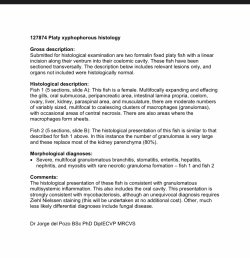Hi all, would want to seek out for help of what happened to my platies, below is the info of the tank,
- all chlorine, nitrite and amonina are 0, some nitrate but i think it does mot bother
- 60 litre aquarium with around 15 platies, they’ve been in the tanks for years and are doing fine.
- these fishes are diagnosed to be infested by mycobacteria (confirmed by vet in lab check on a remain if a deadfish).
They are living fine even with the sickness, and I am keeping the tank condition super well, for years they are doing super fine.
Only until recently, fishes started to have the open-close mouth problem. they started with frequently open and close the mouth, and then the degree if opening is getting bigger, and finally the mouth cannot be closed.
Vet come and pick one of the dead body for lab test, and the result is multi-type of bacteria infestion, however, she still cannot explain why the fish is opening and closing the mouth - oxygen level are good enough for them.
I would want to try my luck of seeing if any experienced folks here had faced this before…i may not be able to cure the disease, but would really want to know what happened so to see if there’s a way to make them more confortable - in all cases, fishes ultimate die because they cannot eat (i tried all minineral substitutes, small food powder and hope they can still eat some, some of them did live longer.
Below video is the best I could do
Thanks!
- all chlorine, nitrite and amonina are 0, some nitrate but i think it does mot bother
- 60 litre aquarium with around 15 platies, they’ve been in the tanks for years and are doing fine.
- these fishes are diagnosed to be infested by mycobacteria (confirmed by vet in lab check on a remain if a deadfish).
They are living fine even with the sickness, and I am keeping the tank condition super well, for years they are doing super fine.
Only until recently, fishes started to have the open-close mouth problem. they started with frequently open and close the mouth, and then the degree if opening is getting bigger, and finally the mouth cannot be closed.
Vet come and pick one of the dead body for lab test, and the result is multi-type of bacteria infestion, however, she still cannot explain why the fish is opening and closing the mouth - oxygen level are good enough for them.
I would want to try my luck of seeing if any experienced folks here had faced this before…i may not be able to cure the disease, but would really want to know what happened so to see if there’s a way to make them more confortable - in all cases, fishes ultimate die because they cannot eat (i tried all minineral substitutes, small food powder and hope they can still eat some, some of them did live longer.
Below video is the best I could do
Thanks!



